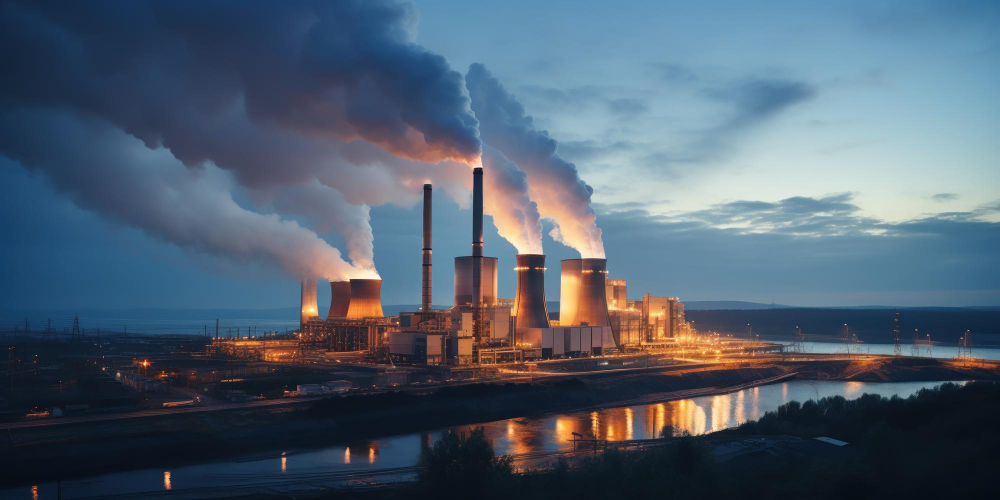To achieve a clean, just, and competitive transition, the European Union must implement a new Clean Industrial Deal that promotes decarbonization alongside sustainable growth and industrial development. Such a strategy should create the right conditions for green investment and tackle sector-specific issues head-on.
PARIS/BRUSSELS – The European Union positioned itself as the global front-runner on climate action five years ago, when it launched the European Green Deal. But building a sustainable economy is even more important now that the effects and costs of global warming are increasing. Moreover, the natural-gas crisis following Russia’s invasion of Ukraine has underscored the need to accelerate decarbonization to secure the bloc’s energy supply, lower its power costs, and foster social cohesion. What began as a climate agenda can now help the EU tackle its existential challenges.
To meet these goals, the EU must implement the Fit for 55 package, which calls for reducing greenhouse-gas (GHG) emissions by at least 55% by 2030, and quickly adopt the proposed target of cutting GHG emissions by 90% by 2040. Back-tracking is not an option, as it would expose the bloc to more adverse climate shocks and further damage its competitiveness and security, while also compromising its global credibility.
To be sure, the path to carbon neutrality will not be easy. As the energy transition gathers pace, questions of fairness will arise, such as who will bear the costs of decarbonizing the building, transport, and agriculture sectors. It may also test the EU’s cohesion, as the emergence of green industries in peripheral regions could reconfigure power within the bloc. Globally, it will raise concerns about ensuring a level playing field with non-EU countries that are not decarbonizing at the same speed.
Achieving a clean, just, and competitive transition requires a new Clean Industrial Deal that promotes decarbonization alongside sustainable growth and industrial development. Such an integrated policy package, which European Commission President Ursula von der Leyen has pledged to advance in the first 100 days of her second mandate, would build support for the green transition, making it politically acceptable.
A European industrial strategy must create the right conditions for investment. For starters, that means making renewables more affordable and spurring their deployment by introducing tax credits, reforming commodity markets, and more. It will also be necessary to cut bureaucratic red tape (without diluting climate policy), such as by accelerating permitting and improving access to funding and markets to mobilize the resources that clean-tech manufacturers need to grow and that energy-intensive industries need to retool.
Fortunately, there are many ways to boost green investment, including by incorporating a public investment rule in the new EU fiscal framework and increasing funding for the European Investment Bank so that it can maximize its ability to de-risk clean-energy investments. The EU could also make better use of its common budget by establishing a new European competitiveness fund – which von der Leyen has also promised to introduce – to spur innovation, and by tying disbursements to the implementation of member states’ national energy and climate plans. A savings and investments union could help as well, by contributing to a more robust European financial market.
Such a strategy could use public procurement to create a domestic market for innovative clean technologies and products that are made in Europe. Of course, as managing resources such as water becomes increasingly important, circular-economy and environmental-protection measures should also feature prominently.
There is also a need to reflect on how to integrate the clean-energy and digital transitions and overcome the trade-offs between the two: for example, data centers require a lot of energy, but digital technologies will be critical to the efficient management of the future power system.
Lastly, workers must be trained for the jobs of the future to mitigate the energy transition’s social impact, especially in regions with carbon-intensive industries.
To address sector-specific issues, a Clean Industrial Deal should subsidize strategic supply chains in technological areas where the EU has a comparative advantage, while taking into consideration the trade-offs between decarbonization, competitiveness, and security. This can be done by “Europeanizing” as much as possible.
Following the recommendations in Mario Draghi’s recent report on European competitiveness, it will be crucial to channel public funding to important projects of common European interest (IPCEIs), and increase the use of instruments such as the Innovation Fund. The European Hydrogen Bank’s pioneering schemes – including auctions-as-a-service, a way for member states to top up EU Innovation Fund allocations to support more projects, and “carbon contracts for difference” to help businesses hedge against future price movements – could serve as a model.
To ensure that scarce resources are allocated to IPCEIs, the European competitiveness fund should be designed to combine new and existing financial instruments. Moreover, the new EU fiscal framework should give preferential treatment to national support for projects, and efforts should be made to source funding from revenues generated by the EU’s Emissions Trading System and member states’ carbon contracts for difference. Any plan for large-scale industrial decarbonization can be credible only if it includes concrete measures to lower the cost of capital and provide sufficient resources.
The Clean Industrial Deal, like the EU’s Carbon Border Adjustment Mechanism and deforestation law, will have global repercussions. To ease geopolitical tensions and diversify its sources of critical raw materials and components, the bloc could develop clean trade and investment partnerships with strategic third countries. Collaborating on green-energy goals with non-EU governments would go a long way toward boosting European competitiveness and security.
But clean trade and investment partnerships can be established only if two conditions are met. First, the so-called “Team Europe approach,” whereby member states join forces on external action, must be scaled up to increase the EU’s leverage in third countries. Second, these partnerships must be coordinated at the executive vice-president level to ensure overall policy coherence and impact.
The political viability of the European Green Deal depends on the EU implementing a policy package that combines decarbonization efforts with measures to boost competitiveness and social cohesion. Implementing a strong Clean Industrial Deal should thus be the main task of the new European Commission.

About the author:
Jean Pisani-Ferry, a senior fellow at the Brussels-based think tank Bruegel and a senior non-resident fellow at the Peterson Institute for International Economics, is a professor at Sciences Po.
Simone Tagliapietra, a senior fellow at the Brussels-based think tank Bruegel, is a professor at the School of Transnational Governance of the European University Institute.
Laurence Tubiana, a former French ambassador to the United Nations Framework Convention on Climate Change, is CEO of the European Climate Foundation and a professor at the École Normale Supérieure.



PARIS/BRUSSELS – The European Union positioned itself as the global front-runner on climate action five years ago, when it launched the European Green Deal. But building a sustainable economy is even more important now that the effects and costs of global warming are increasing. Moreover, the natural-gas crisis following Russia’s invasion of Ukraine has underscored the need to accelerate decarbonization to secure the bloc’s energy supply, lower its power costs, and foster social cohesion. What began as a climate agenda can now help the EU tackle its existential challenges.
To meet these goals, the EU must implement the Fit for 55 package, which calls for reducing greenhouse-gas (GHG) emissions by at least 55% by 2030, and quickly adopt the proposed target of cutting GHG emissions by 90% by 2040. Back-tracking is not an option, as it would expose the bloc to more adverse climate shocks and further damage its competitiveness and security, while also compromising its global credibility.
To be sure, the path to carbon neutrality will not be easy. As the energy transition gathers pace, questions of fairness will arise, such as who will bear the costs of decarbonizing the building, transport, and agriculture sectors. It may also test the EU’s cohesion, as the emergence of green industries in peripheral regions could reconfigure power within the bloc. Globally, it will raise concerns about ensuring a level playing field with non-EU countries that are not decarbonizing at the same speed.
Achieving a clean, just, and competitive transition requires a new Clean Industrial Deal that promotes decarbonization alongside sustainable growth and industrial development. Such an integrated policy package, which European Commission President Ursula von der Leyen has pledged to advance in the first 100 days of her second mandate, would build support for the green transition, making it politically acceptable.
A European industrial strategy must create the right conditions for investment. For starters, that means making renewables more affordable and spurring their deployment by introducing tax credits, reforming commodity markets, and more. It will also be necessary to cut bureaucratic red tape (without diluting climate policy), such as by accelerating permitting and improving access to funding and markets to mobilize the resources that clean-tech manufacturers need to grow and that energy-intensive industries need to retool.
Fortunately, there are many ways to boost green investment, including by incorporating a public investment rule in the new EU fiscal framework and increasing funding for the European Investment Bank so that it can maximize its ability to de-risk clean-energy investments. The EU could also make better use of its common budget by establishing a new European competitiveness fund – which von der Leyen has also promised to introduce – to spur innovation, and by tying disbursements to the implementation of member states’ national energy and climate plans. A savings and investments union could help as well, by contributing to a more robust European financial market.
Such a strategy could use public procurement to create a domestic market for innovative clean technologies and products that are made in Europe. Of course, as managing resources such as water becomes increasingly important, circular-economy and environmental-protection measures should also feature prominently.
There is also a need to reflect on how to integrate the clean-energy and digital transitions and overcome the trade-offs between the two: for example, data centers require a lot of energy, but digital technologies will be critical to the efficient management of the future power system.
Lastly, workers must be trained for the jobs of the future to mitigate the energy transition’s social impact, especially in regions with carbon-intensive industries.
To address sector-specific issues, a Clean Industrial Deal should subsidize strategic supply chains in technological areas where the EU has a comparative advantage, while taking into consideration the trade-offs between decarbonization, competitiveness, and security. This can be done by “Europeanizing” as much as possible.
Following the recommendations in Mario Draghi’s recent report on European competitiveness, it will be crucial to channel public funding to important projects of common European interest (IPCEIs), and increase the use of instruments such as the Innovation Fund. The European Hydrogen Bank’s pioneering schemes – including auctions-as-a-service, a way for member states to top up EU Innovation Fund allocations to support more projects, and “carbon contracts for difference” to help businesses hedge against future price movements – could serve as a model.
To ensure that scarce resources are allocated to IPCEIs, the European competitiveness fund should be designed to combine new and existing financial instruments. Moreover, the new EU fiscal framework should give preferential treatment to national support for projects, and efforts should be made to source funding from revenues generated by the EU’s Emissions Trading System and member states’ carbon contracts for difference. Any plan for large-scale industrial decarbonization can be credible only if it includes concrete measures to lower the cost of capital and provide sufficient resources.
The Clean Industrial Deal, like the EU’s Carbon Border Adjustment Mechanism and deforestation law, will have global repercussions. To ease geopolitical tensions and diversify its sources of critical raw materials and components, the bloc could develop clean trade and investment partnerships with strategic third countries. Collaborating on green-energy goals with non-EU governments would go a long way toward boosting European competitiveness and security.
But clean trade and investment partnerships can be established only if two conditions are met. First, the so-called “Team Europe approach,” whereby member states join forces on external action, must be scaled up to increase the EU’s leverage in third countries. Second, these partnerships must be coordinated at the executive vice-president level to ensure overall policy coherence and impact.
The political viability of the European Green Deal depends on the EU implementing a policy package that combines decarbonization efforts with measures to boost competitiveness and social cohesion. Implementing a strong Clean Industrial Deal should thus be the main task of the new European Commission.
About the author:
Jean Pisani-Ferry, a senior fellow at the Brussels-based think tank Bruegel and a senior non-resident fellow at the Peterson Institute for International Economics, is a professor at Sciences Po.
Simone Tagliapietra, a senior fellow at the Brussels-based think tank Bruegel, is a professor at the School of Transnational Governance of the European University Institute.
Laurence Tubiana, a former French ambassador to the United Nations Framework Convention on Climate Change, is CEO of the European Climate Foundation and a professor at the École Normale Supérieure.